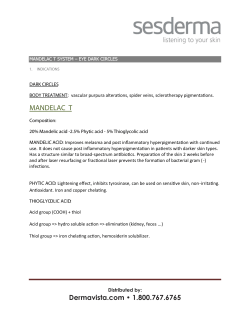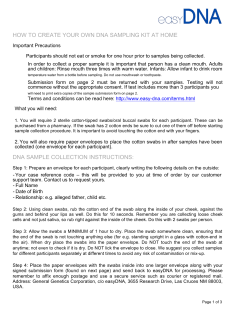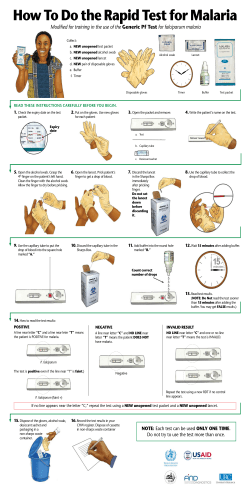
Evaluation of Focus Diagnostics Simplexa™ HSV 1 & 2 Direct
Evaluation of Focus Diagnostics Simplexa™ HSV 1 & 2 Direct Sample-to-Answer Real-time PCR Assay Jules Chen*, Yuan Xie, Luca Jacky, Michael Aye, Michelle Tabb, and Maurice Exner Focus Diagnostics Inc., Cypress, CA 90630, USA Abstract Methods (Cont.) Introduction/Background: The high prevalence of herpes simplex virus (HSV) infections makes it a significant public health concern. Prompt detection and differentiation of HSV infections can assist in patient management, and is especially important in cases of HSV meningoencephalitis. The Simplexa™ HSV 1 & 2 Direct assay is in development as a sample-to-answer multi-analyte detection system performed on the 3M Integrated Cycler instrument. Swabs in viral transport media and CSF specimens are loaded directly onto a Direct Amplification Disc without extraction or other specimen preparation. The goal of this study was to compare the performance of the Simplexa HSV 1 & 2 Direct assay relative to culture and to real-time PCR methods that require extracted specimens. Sensitivity and Specificity: A panel of 279 de-identified clinical specimens (Focus Diagnostics) including swab specimens with previously reported culture or PCR results and CSF specimens with previously reported PCR results were tested by Simplexa HSV 1 & 2 Direct. Simplexa HSV 1 & 2 Direct results were compared with previously reported results to determine positive and negative agreement. Discordant samples were retested by reference PCR Simplexa assay. Materials and Methods: Limit of Detection (LoD) studies were performed to determine the analytical sensitivity of the assay. Inhibition, interference and cross reactivity were evaluated using a panel of bacteria, viruses and potentially interfering substances. Relative sensitivity and specificity were determined by testing blind panels of de-identified patient specimens and comparing results with those obtained using culture or a real-time PCR method that necessitates prior nucleic acid extraction. Results: The LoD studies showed that the Simplexa Direct assay detected HSV-1 strains at less than 40 TCID50/mL and HSV-2 strains at less than 5 TCID50/mL. No inhibition, interference, or cross reactivity was observed. Relative sensitivity and specificity for swab samples were 100% (40/40) and 95.3% (102/107) for HSV-1, and 100% (38/38) and 100% (107/109) for HSV-2 samples. Relative sensitivity and specificity for CSF samples were 97.3% (36/37) and 97.9% (93/95) for HSV-1, and 94.6% (35/37) and 98.9% (94/95) for HSV-2 samples. Conclusion: The Simplexa HSV 1 & 2 Direct assay was capable of directly detecting and differentiating HSV-1 and HSV-2 from un-extracted clinical specimens with performance comparable to culture or a real-time PCR method that uses upfront nucleic acid extraction. The assay and instrumentation provide a compact system for rapid (~1 hour) detection of HSV-1 and HSV-2 directly from swab and CSF samples. Methods HSV virus strains: The following HSV stains were used in the Limit of Detection study: HSV-1 McIntyre (Virapur, San Diego, CA), HSV-1 HF (ATCC, Manassas, VA), HSV-2 G, (Virapur), HSV-2 MS (ATCC). Extraction and Real-time PCR Amplification and Detection: Simplexa HSV 1 & 2 Direct (Focus Diagnostics, Cypress, CA) contains all reagents for extraction and real-time PCR. Sample extraction and real-time PCR was performed using the Direct Amplification Disc (DAD) with 50 µL of sample loaded into the sample port and 50 µL of Simplexa HSV 1 & 2 Direct Reaction Mix loaded into the reaction port. All testing was performed on the 3M Integrated Cycler instruments (3M, St. Paul, MN). Data collection and analysis was performed with Integrated Cycler Studio software. Limit of Detection (LoD): The LoD for each HSV stock was determined as the lowest concentration with ≥95% detection for 20 replicates with pooled negative swab (Focus Diagnostics) and synthetic CSF (Golden West Biologicals, Temecula, CA) matrix. Synthetic CSF LoD was verified by testing against 8 replicates of human pooled CSF (Golden West Biologicals). CFU/mL of Cross Reactivity: The cross reactivity panel was contrived with bacteria or 105 TCID50/mL of virus in either pooled negative swab or synthetic CSF matrix. 106 Inhibition/interference: Interference panel was contrived with HSV-1 or HSV-2 at 2-4 fold above LoD concentration. Each substance was spiked into the HSV-1 or HSV-2 contrived samples and tested by Simplexa HSV 1 & 2 Direct. *Corresponding author: [email protected] Results (Cont.) Results Limit of Detection: HSV-1 (McIntyre and HF strains) LoD was <40 TCID50/mL. HSV-2 (G and MS strains) LoD was <5 TCID50/mL. Results (Cont.) Table 7. Concordance for HSV-2 swab clinical specimens Table 3. Pathogens tested for cross reactivity in CSF Neisseria meningitidis HIV-1 St. Louis Encephalitis Virus Haemophilus influenza B HIV-2 Mycoplasma pneumoniae Streptococcus pneumoniae WNV Mycobacterium tuberculosis Group B streptococcus Measles virus Borellia burgdorferi Listeria monocytogenes Mumps virus Cryptococcus neoformans Inhibition: No interference was detected with the substances tested in Table 4. Matrix Concentration tested Whole Blood swab and CSF 10% (v/v) Female Urine swab 10% (v/v) Table 1. Limit of Detection for HSV-1 and HSV-2 strains HSV-1 Mclntyre TCID50/mL Mean Ct (CFR610) Min. Ct Max. Ct Replicates Detected Albumin (protein) swab and CSF 10 mg/mL Negative swab 10 36.3 34.3 38.8 20/20 Casein (protein) swab and CSF 10 mg/mL Synthetic CSF 10 36.5 34.4 40.7 20/20 K-Y Brand Jelly swab 5% (v/v) Human CSF 10 34.2 33.6 35.6 8/8 Acyclovir (Acycloguanosine) swab and CSF 2.5 mg/mL Betadine (topical antiseptic) swab and CSF 5% (v/v) White Blood Cell CSF 5.5x108 WBC/mL Hemoglobin CSF 0.625 mg/mL HSV-1 HF strain TCID50/mL Mean Ct (CFR610) Min. Ct Max. Ct Replicates Detected Negative swab 30 37.0 35 41.9 20/20 Synthetic CSF 30 36.3 34.6 38.5 20/20 Human CSF 30 36.2 34.3 38.1 8/8 HSV-2 G strain TCID50/mL Mean Ct (FAM) Min. Ct Max. Ct Replicates Detected Negative swab 4.4 35.6 34.9 38.8 20/20 Synthetic CSF 2.2 36.8 35.3 39.6 20/20 Human CSF 2.2 36.4 35 37.2 8/8 Swab CSF Previous Result Culture PCR Max. Ct HSV-1 40 0 37 34.8 34.2 35.3 20/20 HSV-2 38 0 37 Synthetic CSF 0.14 35.3 31.5 38.5 20/20 Negative 49 Human CSF 0.14 34.6 34 35.1 8/8 Total Previous Results Simplexa™ Gardenerella vaginalis Mycoplasma hominis Mobiluncus mulieris Neisseria gonorrhoeae VZV Treponema pallidum Staphylococcus aureus HHV-6 Mycoplasma genitalium Staphylococcus saprophyticus HHV-7 Trichomonas vaginalis Streptococcus pyogenes HHV-8 Bacteroides fragilis Rubella virus HPV Toxoplasma gondii HSV-2 Negative 0 107 107 % Positive Agreement 100% (38/38) Total 38 109 147 % Negative Agreement 98.2% (107/109) HSV-1 Positive HSV-1 Negative Total HSV-1 CSF % Agreement HSV-1 Positive 36 2c 38 HSV-1 Negative 1d 93 94 % Positive Agreement 97.3% (36/37) Total 37 95 132 Previous Results Simplexa™ % Negative Agreement 97.9% (93/95) c Specimen 213 and 268, previously reported as negative, were initially detected as HSV-1 positive by Simplexa with Ct 42.1 and 38.3 respectively. Both specimens were negative upon repeat testing. d Specimen 229, previously reported as HSV-1 positive, was detected as negative by Simplexa. Reference PCR assay also reported as negative. HSV-1 Positive HSV-1 Negative a • Total HSV-1 Swab % Agreement • 45 % Positive Agreement 100% (40/40) • % Negative Agreement 95.3% (102/107) • 40 5 HSV-1 Negative 0 102 102 Total 40 107 147 Total HSV-2 CSF % Agreement HSV-2 Positive 35 1f 36 HSV-2 Negative 2e 94 96 % Positive Agreement 94.6% (35/37) Total 37 95 132 % Negative Agreement 98.9% (94/95) Conclusions 132 HSV-1 Positive HSV-2 Negative HSV-2 Ct was 41.8. 58 20 147 HSV-2 Positive Previous Results Simplexa™ e Table 6. Concordance for HSV-1 swab clinical specimens Table 2. Pathogens tested for cross reactivity in swab matrix EBV 40 fSpecimen 417, previously reported as HSV-1 positive, was detected as HSV-1 and HSV-2 positive by Simplexa. Min. Ct 0.14 Enterovirus 2b Specimens 247 and 269, previously reported as HSV-2 positive, were initially detected as negative by Simplexa. Both specimens were detected as HSV-2 with Ct 39.4 and 38.4 respectively upon repeat. TCID50/mL Escherichia coli 38 PCR Negative swab Chlamydia trachomatis HSV-2 Positive Table 8. Concordance for HSV-1 CSF clinical specimens Table 5. Swab clinical specimens HSV-2 MS strain CMV HSV-2 Swab % Agreement Table 9. Concordance for HSV-2 CSF clinical specimens Replicates Detected Candida albicans Total b Relative Sensitivity and Specificity of the Simplexa HSV 1 & 2 Direct Assay: Percent positive and negative agreement with previous results for HSV-1 and HSV-2 was >95% for swab samples and >94% for CSF samples (Tables 5-9). Mean Ct (FAM) Cross Reactivity: No cross-reactivity was detected with the pathogens tested in Tables 2 and 3. HSV-2 Negative Specimens 55 and 107, previously reported as negative by culture, were detected as HSV-2 positive by Simplexa with Ct 35.8 and 39.6 respectively. Reference PCR assay also reported HSV-2 positive with Ct 38.2 and 41.24 respectively. Table 4. Interference substances tested in swab and/or CSF Interference Substance HSV-2 Positive Previous Results Simplexa™ a Specimen 43, previous reported as negative by PCR, was initially detected as HSV-1 positive by Simplexa with Ct 40.8. This specimen was negative upon repeat testing. Specimens 68 and 108, previously reported as HSV-2 positive culture, were initially detected as both HSV-1 and HSV-2 positive by Simplexa. HSV-1 Ct were 41.4 and 38.2 respectively. These specimens were detected only as HSV-2 upon repeat testing Specimens 100 and 123, previous reported as negative by culture, were detected as HSV-1 positive by Simplexa with Ct 35.3 and 34.6 respectively. Reference PCR assay also reported HSV-1 positive with Ct 33.89 and 34.16 respectively. Simplexa HSV 1 & 2 Direct is a simple and rapid molecular test. The assay provides answers ~1 hour without a separate extraction system. This assay was capable of directly detecting and differentiating HSV-1 and HSV-2 from un-extracted specimens. Performance was comparable to that obtained with culture or a real-time PCR method with upfront nucleic acid extraction Simplexa HSV 1 & 2 Direct is in development. It is not currently available for sale, and is not FDA cleared.
© Copyright 2025











